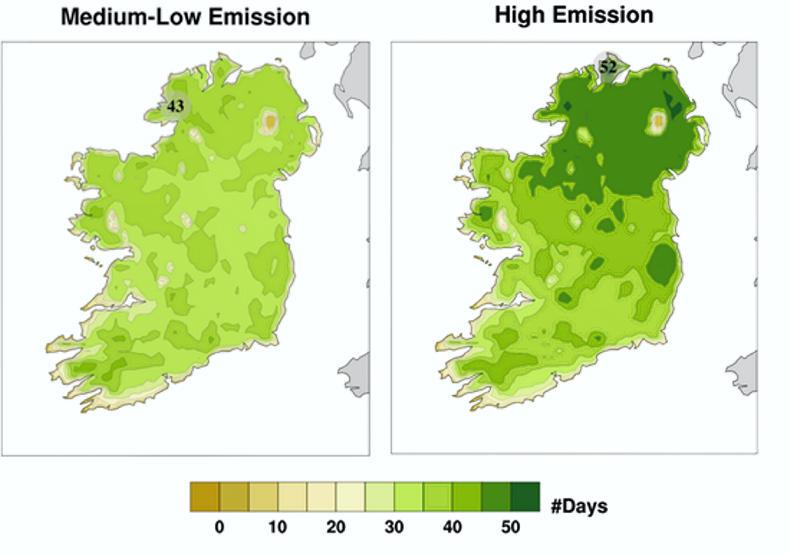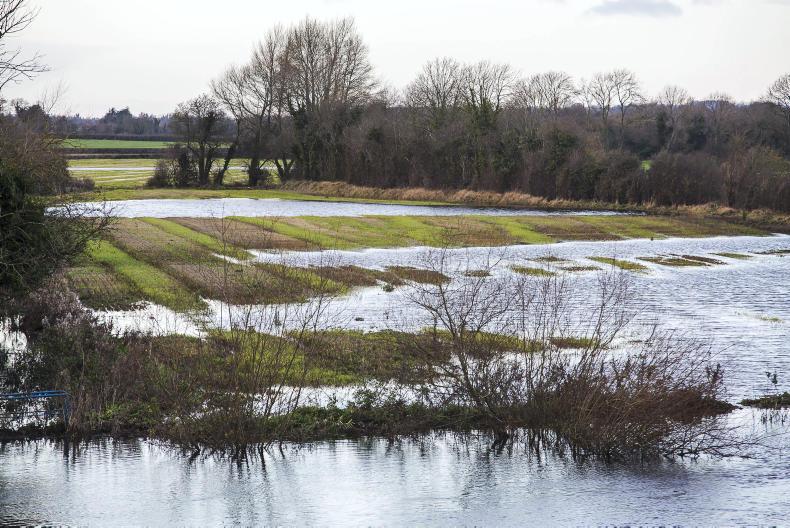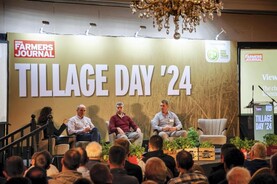Today’s young farmers will see warmer weather, longer growing seasons and more extreme storms before the end of their working life, meteorologists told this week’s Future Weather conference.
Met Éireann’s head climatologist Séamus Walsh said the country’s mean temperature would increase by 1°C to 1.6°C by the middle of this century, with the intensity of climate change determined by the level of global greenhouse gas emissions.
Listen to "What will Irish summers look like in 2050?" on Spreaker.
This will result in fewer frost days each year, but also a higher risk of drought and heat stress on plants and animals.
“There will be wetter winters, with more extreme weather events, which will lead to more flooding,” Walsh said.
He noted that two of the last three winters had seen rainfall levels not seen since 1850. “Clearly, something is happening,” he said.
As a result of milder temperatures “we will have a longer growing season, which is good news in many regards”, he said.

Map of changes in the length of the growing season by the middle of the 21st century. Source: Met Eireann/P. Nolan, EPA Report 223
However, he warned that the extra 30 to 40 days of growth and grazing each year would come with a number of downsides, including new types of animal diseases, pests and invasive species.
Meteorologists including Walsh said the number of storms would decrease slightly, but they would be more likely to be severe. The hurricane-force winds recorded during storm Ophelia in October will become more frequent.
Prof John Fitzgerald, who chairs the Climate Advisory Council, said these changes would be felt differently across Ireland.
“Where you live, how far from the sea, how high, will affect the impact of climate change,” he said.
Met Éireann forecaster Gerry Murphy said the same weather has a different impact depending on how exposed and vulnerable places and people are to it.
“The west coast is more exposed to heavy rainfall, but it doesn’t flood as much because it is better adapted to it,” he said, in contrast to the midlands around the Shannon, for example.
Murphy said his job would increasingly involve working in partnership with people to help them prepare for the impact of the weather rather than just telling them what conditions to expect.
Read more
Met Éireann wants your input to prepare for future weather
Call for action on fodder as crisis looms
Today’s young farmers will see warmer weather, longer growing seasons and more extreme storms before the end of their working life, meteorologists told this week’s Future Weather conference.
Met Éireann’s head climatologist Séamus Walsh said the country’s mean temperature would increase by 1°C to 1.6°C by the middle of this century, with the intensity of climate change determined by the level of global greenhouse gas emissions.
Listen to "What will Irish summers look like in 2050?" on Spreaker.
This will result in fewer frost days each year, but also a higher risk of drought and heat stress on plants and animals.
“There will be wetter winters, with more extreme weather events, which will lead to more flooding,” Walsh said.
He noted that two of the last three winters had seen rainfall levels not seen since 1850. “Clearly, something is happening,” he said.
As a result of milder temperatures “we will have a longer growing season, which is good news in many regards”, he said.

Map of changes in the length of the growing season by the middle of the 21st century. Source: Met Eireann/P. Nolan, EPA Report 223
However, he warned that the extra 30 to 40 days of growth and grazing each year would come with a number of downsides, including new types of animal diseases, pests and invasive species.
Meteorologists including Walsh said the number of storms would decrease slightly, but they would be more likely to be severe. The hurricane-force winds recorded during storm Ophelia in October will become more frequent.
Prof John Fitzgerald, who chairs the Climate Advisory Council, said these changes would be felt differently across Ireland.
“Where you live, how far from the sea, how high, will affect the impact of climate change,” he said.
Met Éireann forecaster Gerry Murphy said the same weather has a different impact depending on how exposed and vulnerable places and people are to it.
“The west coast is more exposed to heavy rainfall, but it doesn’t flood as much because it is better adapted to it,” he said, in contrast to the midlands around the Shannon, for example.
Murphy said his job would increasingly involve working in partnership with people to help them prepare for the impact of the weather rather than just telling them what conditions to expect.
Read more
Met Éireann wants your input to prepare for future weather
Call for action on fodder as crisis looms







 This is a subscriber-only article
This is a subscriber-only article











SHARING OPTIONS: